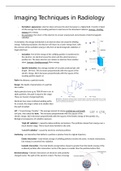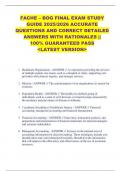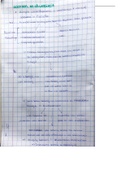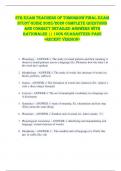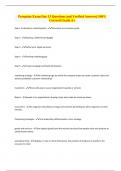Imaging Techniques in Radiology
- Excitation/ appearance: electron does not leave the atom but goes to a highershell. Transfer of (part
of) the energy from the invading particles to electrons in the absorbent material. (energy < binding
energy) Less energy
- De-excitation: the return of the electron to a lower energy level and emission of electromagnetic
radiation.
In excitation, the energy transferred to an electron does not exceed its binding
energy. Following excitation, the electron will return to a lower energy level, with
the emission of the excitation energy in the form of electromagnetic radiation or
Auger electrons.
- Ionization: Part of the energy of the colliding particle is transferred to
the electron. An electron leaves the atom and the atom becomes a
positive ion. The loose electron can release an electron from another
atom. (energy > binding energy) More energy
- Specific ionization: the average number of ion pairs produced per unit
length. (IP/mm). This increases proportionally with the square of the
electric charge. (Q) It decreases proportionally with the square of the
invading particle speed. (v)
Path= the distance a particle travels.
Range= the depth of penetration of a particle
into matter
Alpha particles have up to 7000 IP/mm in air. In
alpha particles, the path is equal to the range.
These are heavier charged particles.
Electrons have more scattered winding paths.
As a result, the range is often a lot smaller than
the path travelled.
LET = "Linear Energy Transfer", The average amount of energy emitted per unit length
(eV/μm). Also called the dose. This increases proportionally with the square of the
electric charge. (Q) it decreases proportionally with the square of the kinetic energy of the particle. (E (k)
Biological consequence of radiation exposure.
"High LET radiation": caused by alpha particles and protons. The particles release their energy over a
much shorter range. This is much more harmful to the cells.
"Low LET radiation": caused by electrons and beta particles.
Scattering = an interaction that deflects a particle or photon from its original trajectory
Elastic interaction = total kinetic energy of colliding particles remains the same. In elastic interactions,
lost energy is converted into radiation.
Inelastic interaction = the total kinetic energy before impact is greater than the kinetic energy of the
scattered particles after interaction. So Ek of the pieces is smaller than the particles before that.
Bremsstrahlung = inelastic interactions of electrons with positively
charged nuclei. The path of the electron is bent. The loss of energy
,is immediately converted into electromagnetic radiation. (X-rays) have a wavelength between 10 and 1000 cm
"braking radiation" or "deceleration radiation", is electromagnetic radiation produced by the
deceleration of a charged particle when deflected by another charged particle, typically an electron by an
atomic nucleus. The moving particle loses kinetic energy, which is converted into radiation (i.e., a photon), thus
satisfying the law of conservation of energy.
Bremsstrahlung emission per atom increases proportionally to the square of the atomic number of the
absorbent atom, (Z) and decreases proportionally to the square of the mass of the colliding particle.
(m) (∞ Z2/m2)
Positron destruction: A positron does not survive very long due to the
amount of electrons in the air. When a positron reaches the end of its
range, it interacts with a negatively charged electron. This results in the
destruction of the positron electron pair. Their mass is converted into
energy, in the form of two opposing targeted 0.511-MeV destruction
photons.
X-ray and gamma radiation interactions: there are 4 types of
interactions of X-ray and gamma radiation photons with matter:
1. Rayleigh scattering = interaction of photon with total atom. It is coherent scattering, which means
that there is no energy loss Ek is equal. Occurs mainly in very low-energy X-rays, such as those
used in mammography (15 to 30 keV). A scattered photon has a slightly different angle when
leaving the atom.
2. Compton scattering = inelastic interaction with an orbital electron. The
electron is ejected from the atom. The scattered photon has less
energy than the colliding photon had. Predominant interaction of
X-ray and gamma ray x-rays in the diagnostic energy range with
soft tissue. (This scattering is most commonly used in soft tissue
and is therefore more important than Rayleigh scattering.)
3. Photoelectric absorption = All invading photon energy is transferred to an electron from one of
the inner shells. The electron is ejected from the atom. As a result, the atom is ionized. The
electrons of the outer shells fall through a cascade to the inner shells. Each electron invading
transmits a photon. The photon that comes from the inner electron has a higher energy than the
others. This scattering is the most important in bone absorption.
4. Pair of production = interaction of a
photon with the electric field of the
nucleus of an atom. The energy of
photon is converted into an
electron-positron pair. Occurs in X-
ray and gamma radiation with high
energetic photons of more than
1.02MeV.
The first three play a role in diagnostic radiology
and nuclear medicine. X-rays and CT scans have
little photoelectric effect but a lot of
Compton effect.
Weakening X-ray and gamma rays: the weakening of radiation is
the removal of photons from a beam as
it passes through matter. This
weakening is caused by absorption and
, scattering of all four effects. The attenuation depends very much on the atomic number of the affected atoms
and the photon energy.
100% absorption 0% Compton scatter
For soft tissues, the Compton effect dominates.
Linear coefficient of attenuation = the fraction of the
photons removed
from a monoenergy X-ray or
gamma radiation per thickness unit of the material. (µ)
[cm -1]
Soft tissue 30-100 keV: μ = 0.35 – 0.16 cm-1
Mass attenuation coefficient = The linear attenuation coefficient
normalized by unit density. (cm 2/g) The weakening coefficient (μ) is
determined by the amount of energy, not by the material.
The mass attenuation coefficient has been counted for many substances
Half value thickness (HVL) = the thickness of a
material needed to reduce the intensity of the X-ray or gamma rays by half. (mm AI) This is measured with
"Narrow-Beam geometry" because otherwise too
many scattered electrons will come on the
detector.
HVL = 0.693/mu
Mu= -ln(%)/thickness thickness =cm
%(in kommagetal)=e^(-mu/dictate)
Effective energy = estimated penetration strength of the X-rays. (keV) This is related to the half value thickness.
Beam hardening = shifting the X-ray spectrum to a higher effective energy. Lower energetic photons of
polyenergy X-rays can be removed by shining the beam through a matter. (see filtered bremsstrahlung)
The internal filter does not remove X-rays of 10keV or less from the X-ray tube
Production of X-rays: X-rays are made by converting
kinetic energy from electrons to electromagnetic radiation,
by allowing them to engage in inhibiting interactions with a
particular material.
Bremsstrahlung spectrum is created by creating a voltage
difference of 20-150kV between the cathode and anode.
The voltage on the system accelerates the escaping
electrons. For the most part, this radiation consists of
electrons, because they have a small mass. The closer the
electron gets to the nucleus of an atom, the higher the
photon energy that will be released will be.
The likelihood of electron interaction depends on the radial distance (distance from the nucleus). Smaller radial
distance gives a greater chance, but a lower energy radiation. The number of X-rays decreases linearly with the
- Excitation/ appearance: electron does not leave the atom but goes to a highershell. Transfer of (part
of) the energy from the invading particles to electrons in the absorbent material. (energy < binding
energy) Less energy
- De-excitation: the return of the electron to a lower energy level and emission of electromagnetic
radiation.
In excitation, the energy transferred to an electron does not exceed its binding
energy. Following excitation, the electron will return to a lower energy level, with
the emission of the excitation energy in the form of electromagnetic radiation or
Auger electrons.
- Ionization: Part of the energy of the colliding particle is transferred to
the electron. An electron leaves the atom and the atom becomes a
positive ion. The loose electron can release an electron from another
atom. (energy > binding energy) More energy
- Specific ionization: the average number of ion pairs produced per unit
length. (IP/mm). This increases proportionally with the square of the
electric charge. (Q) It decreases proportionally with the square of the
invading particle speed. (v)
Path= the distance a particle travels.
Range= the depth of penetration of a particle
into matter
Alpha particles have up to 7000 IP/mm in air. In
alpha particles, the path is equal to the range.
These are heavier charged particles.
Electrons have more scattered winding paths.
As a result, the range is often a lot smaller than
the path travelled.
LET = "Linear Energy Transfer", The average amount of energy emitted per unit length
(eV/μm). Also called the dose. This increases proportionally with the square of the
electric charge. (Q) it decreases proportionally with the square of the kinetic energy of the particle. (E (k)
Biological consequence of radiation exposure.
"High LET radiation": caused by alpha particles and protons. The particles release their energy over a
much shorter range. This is much more harmful to the cells.
"Low LET radiation": caused by electrons and beta particles.
Scattering = an interaction that deflects a particle or photon from its original trajectory
Elastic interaction = total kinetic energy of colliding particles remains the same. In elastic interactions,
lost energy is converted into radiation.
Inelastic interaction = the total kinetic energy before impact is greater than the kinetic energy of the
scattered particles after interaction. So Ek of the pieces is smaller than the particles before that.
Bremsstrahlung = inelastic interactions of electrons with positively
charged nuclei. The path of the electron is bent. The loss of energy
,is immediately converted into electromagnetic radiation. (X-rays) have a wavelength between 10 and 1000 cm
"braking radiation" or "deceleration radiation", is electromagnetic radiation produced by the
deceleration of a charged particle when deflected by another charged particle, typically an electron by an
atomic nucleus. The moving particle loses kinetic energy, which is converted into radiation (i.e., a photon), thus
satisfying the law of conservation of energy.
Bremsstrahlung emission per atom increases proportionally to the square of the atomic number of the
absorbent atom, (Z) and decreases proportionally to the square of the mass of the colliding particle.
(m) (∞ Z2/m2)
Positron destruction: A positron does not survive very long due to the
amount of electrons in the air. When a positron reaches the end of its
range, it interacts with a negatively charged electron. This results in the
destruction of the positron electron pair. Their mass is converted into
energy, in the form of two opposing targeted 0.511-MeV destruction
photons.
X-ray and gamma radiation interactions: there are 4 types of
interactions of X-ray and gamma radiation photons with matter:
1. Rayleigh scattering = interaction of photon with total atom. It is coherent scattering, which means
that there is no energy loss Ek is equal. Occurs mainly in very low-energy X-rays, such as those
used in mammography (15 to 30 keV). A scattered photon has a slightly different angle when
leaving the atom.
2. Compton scattering = inelastic interaction with an orbital electron. The
electron is ejected from the atom. The scattered photon has less
energy than the colliding photon had. Predominant interaction of
X-ray and gamma ray x-rays in the diagnostic energy range with
soft tissue. (This scattering is most commonly used in soft tissue
and is therefore more important than Rayleigh scattering.)
3. Photoelectric absorption = All invading photon energy is transferred to an electron from one of
the inner shells. The electron is ejected from the atom. As a result, the atom is ionized. The
electrons of the outer shells fall through a cascade to the inner shells. Each electron invading
transmits a photon. The photon that comes from the inner electron has a higher energy than the
others. This scattering is the most important in bone absorption.
4. Pair of production = interaction of a
photon with the electric field of the
nucleus of an atom. The energy of
photon is converted into an
electron-positron pair. Occurs in X-
ray and gamma radiation with high
energetic photons of more than
1.02MeV.
The first three play a role in diagnostic radiology
and nuclear medicine. X-rays and CT scans have
little photoelectric effect but a lot of
Compton effect.
Weakening X-ray and gamma rays: the weakening of radiation is
the removal of photons from a beam as
it passes through matter. This
weakening is caused by absorption and
, scattering of all four effects. The attenuation depends very much on the atomic number of the affected atoms
and the photon energy.
100% absorption 0% Compton scatter
For soft tissues, the Compton effect dominates.
Linear coefficient of attenuation = the fraction of the
photons removed
from a monoenergy X-ray or
gamma radiation per thickness unit of the material. (µ)
[cm -1]
Soft tissue 30-100 keV: μ = 0.35 – 0.16 cm-1
Mass attenuation coefficient = The linear attenuation coefficient
normalized by unit density. (cm 2/g) The weakening coefficient (μ) is
determined by the amount of energy, not by the material.
The mass attenuation coefficient has been counted for many substances
Half value thickness (HVL) = the thickness of a
material needed to reduce the intensity of the X-ray or gamma rays by half. (mm AI) This is measured with
"Narrow-Beam geometry" because otherwise too
many scattered electrons will come on the
detector.
HVL = 0.693/mu
Mu= -ln(%)/thickness thickness =cm
%(in kommagetal)=e^(-mu/dictate)
Effective energy = estimated penetration strength of the X-rays. (keV) This is related to the half value thickness.
Beam hardening = shifting the X-ray spectrum to a higher effective energy. Lower energetic photons of
polyenergy X-rays can be removed by shining the beam through a matter. (see filtered bremsstrahlung)
The internal filter does not remove X-rays of 10keV or less from the X-ray tube
Production of X-rays: X-rays are made by converting
kinetic energy from electrons to electromagnetic radiation,
by allowing them to engage in inhibiting interactions with a
particular material.
Bremsstrahlung spectrum is created by creating a voltage
difference of 20-150kV between the cathode and anode.
The voltage on the system accelerates the escaping
electrons. For the most part, this radiation consists of
electrons, because they have a small mass. The closer the
electron gets to the nucleus of an atom, the higher the
photon energy that will be released will be.
The likelihood of electron interaction depends on the radial distance (distance from the nucleus). Smaller radial
distance gives a greater chance, but a lower energy radiation. The number of X-rays decreases linearly with the

